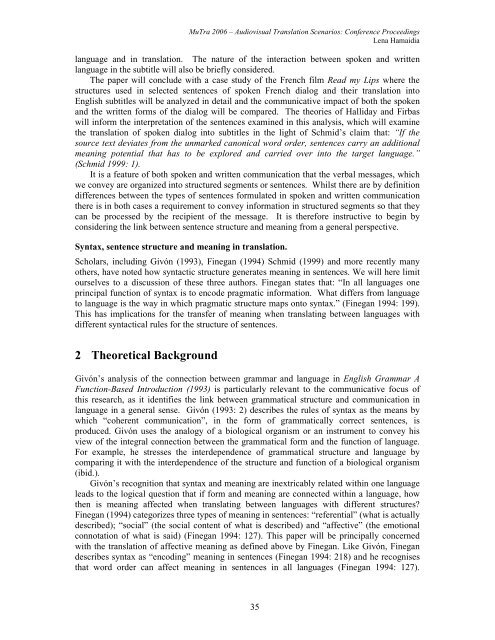Proceedings - Translation Concepts
Proceedings - Translation Concepts
Proceedings - Translation Concepts
Create successful ePaper yourself
Turn your PDF publications into a flip-book with our unique Google optimized e-Paper software.
MuTra 2006 – Audiovisual <strong>Translation</strong> Scenarios: Conference <strong>Proceedings</strong><br />
Lena Hamaidia<br />
language and in translation. The nature of the interaction between spoken and written<br />
language in the subtitle will also be briefly considered.<br />
The paper will conclude with a case study of the French film Read my Lips where the<br />
structures used in selected sentences of spoken French dialog and their translation into<br />
English subtitles will be analyzed in detail and the communicative impact of both the spoken<br />
and the written forms of the dialog will be compared. The theories of Halliday and Firbas<br />
will inform the interpretation of the sentences examined in this analysis, which will examine<br />
the translation of spoken dialog into subtitles in the light of Schmid’s claim that: “If the<br />
source text deviates from the unmarked canonical word order, sentences carry an additional<br />
meaning potential that has to be explored and carried over into the target language.”<br />
(Schmid 1999: 1).<br />
It is a feature of both spoken and written communication that the verbal messages, which<br />
we convey are organized into structured segments or sentences. Whilst there are by definition<br />
differences between the types of sentences formulated in spoken and written communication<br />
there is in both cases a requirement to convey information in structured segments so that they<br />
can be processed by the recipient of the message. It is therefore instructive to begin by<br />
considering the link between sentence structure and meaning from a general perspective.<br />
Syntax, sentence structure and meaning in translation.<br />
Scholars, including Givón (1993), Finegan (1994) Schmid (1999) and more recently many<br />
others, have noted how syntactic structure generates meaning in sentences. We will here limit<br />
ourselves to a discussion of these three authors. Finegan states that: “In all languages one<br />
principal function of syntax is to encode pragmatic information. What differs from language<br />
to language is the way in which pragmatic structure maps onto syntax.” (Finegan 1994: 199).<br />
This has implications for the transfer of meaning when translating between languages with<br />
different syntactical rules for the structure of sentences.<br />
2 Theoretical Background<br />
Givón’s analysis of the connection between grammar and language in English Grammar A<br />
Function-Based Introduction (1993) is particularly relevant to the communicative focus of<br />
this research, as it identifies the link between grammatical structure and communication in<br />
language in a general sense. Givón (1993: 2) describes the rules of syntax as the means by<br />
which “coherent communication”, in the form of grammatically correct sentences, is<br />
produced. Givón uses the analogy of a biological organism or an instrument to convey his<br />
view of the integral connection between the grammatical form and the function of language.<br />
For example, he stresses the interdependence of grammatical structure and language by<br />
comparing it with the interdependence of the structure and function of a biological organism<br />
(ibid.).<br />
Givón’s recognition that syntax and meaning are inextricably related within one language<br />
leads to the logical question that if form and meaning are connected within a language, how<br />
then is meaning affected when translating between languages with different structures?<br />
Finegan (1994) categorizes three types of meaning in sentences: “referential” (what is actually<br />
described); “social” (the social content of what is described) and “affective” (the emotional<br />
connotation of what is said) (Finegan 1994: 127). This paper will be principally concerned<br />
with the translation of affective meaning as defined above by Finegan. Like Givón, Finegan<br />
describes syntax as “encoding” meaning in sentences (Finegan 1994: 218) and he recognises<br />
that word order can affect meaning in sentences in all languages (Finegan 1994: 127).<br />
35
















